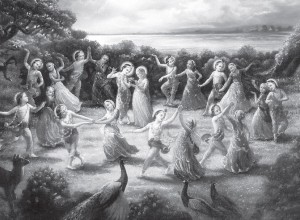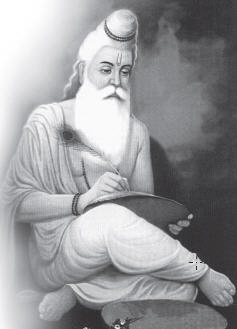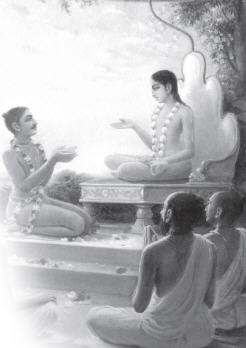
Understanding the male and female aspects of God's divinity can clear away most misunderstandings about the personality of Krishna.
Whenever we tell someone that we worship Lord Krishna, they are often taken by surprise: “How can you worship a God that is immoral?” They refer to Krishna’s stealing of the garments of the unmarried women and His dancing with cowherd damsels of Vrindavana. How could Krishna dare to take away the clothes of young girls and force them to stand naked before him? How could He dance with other men’s wives in the middle of night? And for all this, He is worshiped as God? That’s outrageous!
These are some of the most misunderstood pastimes of Lord Krishna. Srila Bhaktivinoda Thakura, a great nineteenth-century saint, had predicted that one of the challenges for the modern man in understanding the Srimad-Bhagavatam would be the Tenth Canto, where Krishna’s loving pastimes with the gopis are discussed. One may wonder, how can a book that is considered the summum bonum, the culmination of all philosophical understanding and the highest wisdom of a tradition, glorify such activities as most worshipable? Bhaktivinoda Thakura answers this question by posing a counter-question: If a lay person can know that such activities are abominable, wouldn’t Vyasadeva, the author of Bhagavatam, and Sukadeva Gosvami, the narrator of Bhagavatam, know this fact? Vyasadeva was the literary incarnation of God, and Sukadeva Gosvami was a paramahamsa, a person in the highest renounced order of life. Why would they discuss these topics if these topics were immoral?
It is interesting to note that throughout the first nine cantos of the Srimad-Bhagavatam, Vyasadeva condemns material attachment and the degrading power of lust. Through the stories of Ajamila, Saubhari, and Pururava, we understand the dangers of illicit sex and sexual immorality. Eventually when we learn about Krishna’s apparent immorality in the Tenth Canto, it should open our minds and make us realize that this is something drastically different than what we have encountered so far. These activities must be special, supra mundane, and transcendental.
Lust and Love: Perversion and Original
The Vedic understanding is that God has both a male and female aspect of divinity. This divinity manifests in the form Radha-Krishna, Laksmi-Narayana, or Sita-Rama. The Caitanya-caritamrta describes:
radha-Krishna eka atma, dui deha dhari’
anyone vilase rasa asvadanakari’
“Radha and Krishna are one and the same, but They have assumed two bodies. Thus They enjoy each other, tasting the mellows of love.”
Both members of the divine couple are God in identity, but both are not God in personality. It is one person who manifests different personalities. The female form Radharani (and similarly Laksmi and Sita) is God in identity but without the personality of God. She has a female form and a female mood, and in that way she exchanges love with Krishna. So Krishna is the Supreme God, and Radharani is the same God in the form of His topmost devotee. Radharani’s confidential associates, the gopis and sakhis, are Her female expansions who assist Her in Her service to Krishna. They too are not God in identity but the devotees of God.
Before we can understand and appreciate the esoteric activities between the male and female divine forms, we need to understand that we are neither male nor female. As spirit souls separate from the body, our material identity as male or female has no spiritual significance. And therefore we can never judge Krishna’s activities based on the activities of men and women in this world.
The Bhagavad-gita (15.1) explains that everything in the material world is a perverted reflection of things in the spiritual world, where everything exists in its original pure state.The male and female forms in human society are fashioned according to the divine gender forms of God. God and the spiritual world are perfect and complete, but their reflected forms in the material world are influenced by the three modes of material nature. As we see, one of the strongest relations and emotions in this world is the one between a male and a female, and the whole world is moving under its spell. Unfortunately, this emotion often takes many ugly and horrible forms under the spell of the modes. The spiritual world, being free from the influence of the modes, presents this emotion in its pristine form.
Gopis’ Love for Krishna is Supreme
Before introducing Krishna’s loving pastimes with the gopis, the Srimad-Bhagavatam discusses Krishna’s intimate love for so many other devotees in various other incarnations. Lord Narsimhadeva’s love for Prahlada, Lord Rama’s love for Hanuman, Lord Visnu’s love for the associates of Vaikuntha, Krishna’s love for the Pandavas and Parikshit, and Krishna’s love for the cowherd boyfriends and his parents Nanda and Yashoda, are described in great detail to show how love is the main ingredient that attracts the Lord, not the external physical form. Great sages like Narada Muni and the four Kumaras, demigods like Lord Brahma and Lord Shiva, kings like Ambarisa and Bharata, and demons like Vrtrasura, have expressed their deep devotion through their prayers. In this way, through the multiplicity of human-divine relationships, the SB reminds us about God’s unlimited love for us, so we give up our attachment to the temporary world of matter and instead cultivate our lost love with the Supreme Lord. The focus is not on male-female relationships alone, but on the relationship between God and His devotee. Whether Lord Narsimhadeva embraces Prahlada, or Lord Rama embraces Hanuman, or Krishna embraces the gopis, all such dealings are based on pure spiritual love. Although there are dramatic differences in the appearance and form of each devotee, the devotional mood has always been the common element that comes out of each story.
Once we understand this fundamental principle behind each narration of the Bhagavatam, we can safely venture into understanding Krishna’s dealings with the gopis. Krishna is not an ordinary male but the Supreme Personality of Godhead, and the gopis, headed by Radharani, are not ordinary women but the topmost devotees of Krishna. This of course does not mean that the male and female forms, or any other form in the spiritual world, are unimportant. Once we understand that spiritual dealings are untainted by material contamination, and once we appreciate the substance of devotion, the Bhagavatam then reveals the higher reality about various levels of devotion.
Ordinarily we would say that lust, or the desire to satisfy one’s own senses, is selfish, so naturally love would mean selflessness. But Srila Krishnadasa Kaviraja Gosvami goes one step further in order to distinguish love from lust. He says:
atmendriya-priti-vancha
tarebali ‘kama’
krsnendriya-priti-iccha
dhare ‘prema’ nama
“The desire to gratify one’s own senses is kama [lust], but the desire to please the senses of Lord Krishna is prema [love].” (Cc. adi 4.165)

The important thing to note in this definition is that Krishna has senses, just as we have ours. God is not just an abstract impersonal concept; He has eyes, ears and other senses. More than getting over the selfish desire to satisfy one’s own senses, the desire to satisfy Krishna’s senses is the complete definition of love.The highest summit of selflessness is when our desires are God-centered.
There are five primary devotional mellows, or rasas, in which devotees serve Krishna: Santa, dasya, sakhya, vatsalya and madhurya. Each rasa is meant to give Krishna pleasure in a specific way, and different devotees in the spiritual world serve Krishna in one of these rasas. Even the Santa-rasa the lowest in the transcendental hierarchy is characterized by complete detachment from material desire, which means the love is not based on the external appearance as a male or female.
Among the five rasas, the madhurya-rasa is considered the highest, and the devotees serving Krishna in this rasa are the topmost. The gopis want to offer the best food and drinks to Krishna, they decorate themselves beautifully so Krishna is happy looking at them, they sing the best songs to please Krishna, they dance for Krishna’s pleasure, and in this way they try to satisfy Krishna in all possible ways. Krishna, Radharani, the gopis and all the devotees have their individual spiritual forms, and they please Krishna in their personal ways.
This is the real point of transcendence. Spiritual life is a living loving reality, where every individual has a specific mood and form. The way reality appears in this world gives an indication of the reality of spiritual world.As we see, the female form manifested in human society is suited to offer the best service to the male form. Modern women may reject this as male chauvinism, but a look at the robust traditional family units in India will reveal this to be true. When love and trust exist in a relationship, there is no exploitation. The male-female relation is based on mutual service, but the service the male offers to the female and the female offers to male are different. This cooperative and loving relationship has its origin in the spiritual relationship between the male and female forms of God.
The selfless nature of the gopis’ love was proved when once Krishna pretended to be sick, and no physician could cure Him. “If I put the dust from the feet of My devotees on my head,” Krishna said, “I can be cured.” But who would dare to put their dust on Krishna’s head? Everyone refused. When the gopis learned of Krishna’s suffering and the way to relieve Him of the pain, they immediately agreed to take the dust from their feet and put it on Krishna’s head. They didn’t care about the consequences, and they were prepared to suffer in hell for the rest of eternity if they could give a moment’s pleasure to Krishna. This selfless nature of the gopis qualifies them to become the topmost devotees of Krishna, and their female forms allow them to offer the highest service in madhurya-rasa.
Krishna’s Upholds Morality
Many young gopis had worshiped goddess Katyayani in order to get Krishna as their husband. They didn’t want to have anyone as their husband, and they eagerly hoped that Krishna would marry them. Understanding the hearts of the gopis, Krishna decided to fulfill their desire. One day as the gopis entered the Yamuna waters leaving their clothes on the riverbank, Krishna suddenly appeared there, took all their garments, and climbed a nearby kadamba tree. He demanded that if the gopis wished to get their clothes back, they would have to come out naked and collect their clothes.
In his purport to this pastime, Srila Prabhupada explains that in the Vedic culture a woman’s wealth was her chastity. When she gets married, she can appear unclothed only in front of her husband. When Krishna demanded that the gopis appear naked in front of Him, He was not hankering to enjoy their naked beauty if that were His intention, He could have exploited them without returning their clothes. Instead He was eager to fulfill their desires and accept them as their wives. He was accepting the mood and purpose behind their act.
In the Mahabharata when the Kauravas attempted to insult Draupadi in an open assembly, Krishna miraculously appeared there and protected her chastity by supplying her unlimited amount of cloth. He protects and upholds the morality of His devotees.
Krishna Demands Transcendental Morality
Following moral principles, though superior to being immoral, is not the perfection of spiritual life. Krishna demands that one transcend all morality for the sake of achieving Him, which is beyond the confines of even moral principles.

After instructing Arjuna on many subject matters, Krishna towards the end of the Bhagavad-gita urges him to give up all varieties of religion and surrender to Him completely. Sarva-dharman parityajya mam ekam Saranam vraja/ aham tvam sarva-papebhyo moksayisyami ma Sucaù: “Abandon all varieties of religion and just surrender unto Me. I shall deliver you from all sinful reactions. Do not fear.”
In the Srimad-Bhagavatam we also read about the wives of the ritualistic brahmanas. When they heard that Krishna-Balarama and their cowherd boyfriends were hungry, they immediately collected the entire foodstuff, which was meant to be used by the brahmanas in the sacrifice, and took them to where Krishna was. Disregarding all the threats from their husbands and elders, they approached Lord Krishna and pleaded with Him to accept them. In other words, they transcended all social customs and achieved the perfection of life by surrendering everything to Krishna. Interestingly, Krishna advised them to go back to their homes and follow their household duties. He assured them that they need not fear rejection from the family. They can remain united with Him by constantly remembering and chanting His glories.
On the other hand, when the gopis came to dance with Krishna in the middle of the night, Krishna similarly advised them to return to their homes. The gopis too, like the brahmana-patnis, had disregarded their elders in order to serve Krishna. They were ready even to give up their chastity to their husbands at the risk of being ostracized from society. But they could not follow Krishna’s order out of their intense love for Him. And Krishna too could not refuse to accept their love.
The gopis thus demonstrated the supreme level of renunciation, and that is the reason they are known as the greatest devotees of Krishna. They transcended all moral obligations, including their chastity, and surrendered their lives completely to Him.
In ordinary human dealings, if a woman gives up her husband to go with her paramour, that is considered immoral and scandalous, because it is based on selfish sensual pleasure. But in the case of transcendental immorality, morality is given up for the sake of serving Krishna, and that is supremely glorious. Giving up sinful activities and selfish temptations is certainly good, but giving up pious activities and our attachment to the good of this world for the sake of devotion to God is the highest good, the supreme religion. The gopis exemplified this quality to its perfection.
Lord Krishna Proves His Godhood
Sukadeva Gosvami explains to Parikshit that Krishna’s violation of moral principles for the sake of His devotees proves His position as the Supreme Personality of Godhead. If He were bound by moral codes of human society, how can He be called God? Krishna is above all morality and immorality, not vice-versa. When He appears to violate morality, He is not being immoral but is demonstrating His supremacy over morality. Unlike us, who are tempted to break moral principles by the force of alluring temptations, Krishna is never motivated by selfish desire. He is always motivated by love, and everyone gets the supreme benefit whenever He breaks any moral principle.
In conclusion, we can understand from the activities of Krishna and the gopis that it is neither morality nor God that reigns supreme. It is love that reigns supreme, even above God. Krishna does not care to display His supreme divinity in front of His most confidential devotees. The Vrajavasis do not like to treat Krishna as God. All they know is that Krishna is their most lovable object. Under such circumstances, Krishna is forced to conceal His divinity. And as a result He feels free to exchange the most loving relations in the sweetest possible manner.
Mukundamala Dasa is a member of the BTG India editorial team.
